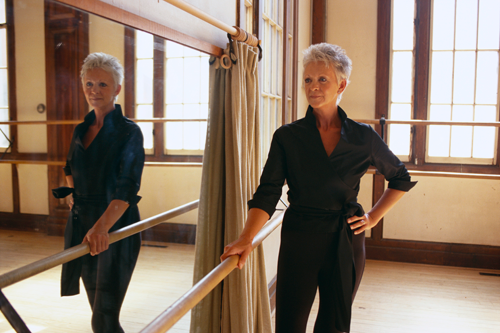 It’s a disorienting decision—certainly for someone who makes a living selling words—to choose a form of expression that doesn’t use them. But I’d always dreamed of choreographing—not for a living but for fun. I wanted to see if I could learn its own unfamiliar and difficult language.
It’s a disorienting decision—certainly for someone who makes a living selling words—to choose a form of expression that doesn’t use them. But I’d always dreamed of choreographing—not for a living but for fun. I wanted to see if I could learn its own unfamiliar and difficult language.
Five months ago, I started a weekly class in modern-dance choreography. I’ve studied ballet and jazz dance for decades, off and on, but never studied modern, preferring the formal vocabulary and familiarity of the other two. Modern somehow seemed a poor fit for me.
As a writer, my audience typically remains safely distant and invisible. Here I had to look someone in the eye, and see myself in the mirror, expressing my ideas without words, using only corporeal language. Would my teacher and classmate be able to hear me, to—literally—see my point?
In class we had to warm up, then move, write about movement, and create “insta-dances” that we would perform on the spot and discuss. The very idea initially scared the hell out of me, which was also the root of its appeal—I thought a tough new physical and intellectual challenge would be a great way to jump-start my thinking.
As someone who writes for a living, every word I publish, anywhere, is carefully considered and revised many times before I expose it to others’ views and opinions. But choreography class demands a wholly different way of thinking, creating, and responding to others—it’s intimate, instant, spontaneous, and public. Even with an audience of only two, I felt awkward at first, scared of being judged and deemed clumsy and foolish.
As a writer, my audience typically remains safely distant and invisible. Here I had to look someone in the eye, and see myself in the mirror, expressing my ideas without words, using only corporeal language. Would my teacher and classmate be able to hear me, to—literally—see my point?
In the studio there’s no time or space for foot-dragging, procrastination, or perfectionism, all of which writers are prone to. We could easily lose 20 to 30 minutes of valuable class time if we allow ourselves to be passive or ambivalent about our ideas. It’s better to just put something out there and mess with it.
The other student described me as both graceful and expressive, for which I was surprised and grateful. I often see my aging body more as a tiresome battleground, something to control and master, not enjoy and celebrate. Now, seeing my own movements in such detail forces me to fully acknowledge and respect what it—what I—can do.
The other student described me as both graceful and expressive, for which I was surprised and grateful. I often see my aging body more as a tiresome battleground, something to control and master, not enjoy and celebrate. Now, seeing my own movements in such detail forces me to fully acknowledge and respect what it—what I—can do.
There are no rules in the studio. I can just start moving to the music and see what happens. Truthfully, it’s a little terrifying to have all that creative freedom. For decades I’ve been churning out words to a specific length, style, and audience, like a tailor making a gray wool pinstriped suit in a 42 tall. I’m accustomed to producing something made-to-order, rarely a pure expression of my own ideas.
How liberating, then, to open the cage of words and flutter into the air beyond.



